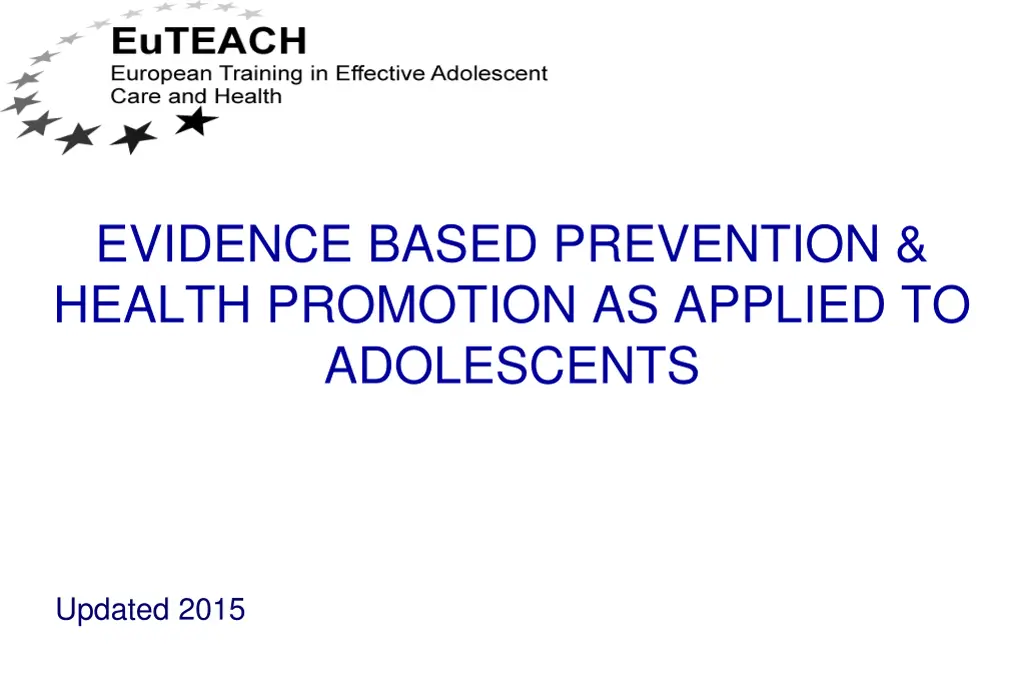
Evidence-Based Prevention and Health Promotion Strategies for Adolescents
Explore evidence-based approaches for preventing health issues and promoting well-being among adolescents. Learn about adolescent brain development, ethical considerations, and the importance of creating safe environments. Discover strategies for integrating prevention and health promotion in various settings.
Download Presentation

Please find below an Image/Link to download the presentation.
The content on the website is provided AS IS for your information and personal use only. It may not be sold, licensed, or shared on other websites without obtaining consent from the author. If you encounter any issues during the download, it is possible that the publisher has removed the file from their server.
You are allowed to download the files provided on this website for personal or commercial use, subject to the condition that they are used lawfully. All files are the property of their respective owners.
The content on the website is provided AS IS for your information and personal use only. It may not be sold, licensed, or shared on other websites without obtaining consent from the author.
E N D
Presentation Transcript
EVIDENCE BASED PREVENTION & HEALTH PROMOTION AS APPLIED TO ADOLESCENTS Updated 2015
So far we have covered... Adolescent development and how to address some clinical situations in an effective way How to gather and interpret relevant indicators in the field of adolescent health
Objectives 1. Identify some major areas in which prevention & health promotion strategies can be developed 2. Review existing evidences in the field of prevention & health promotion 3. Integrate the different steps involved in the design, implementation and evaluation of an intervention
The adolescent brain Pruning Late development of pre frontal cortex Volkow 2005; Ruben & Baler, 2006; Goldstein & al, 2002-2007; Giedd, 2008
Ethical statement.. he best way to improve the health of adolescent is to create safe environments
Identify the major areas in which prevention & health promotion should be developed
SHORT GROUP DISCUSSION What would be the most important issues in your country/region?
Evidences in the field of prevention & health promotion
SHORT GROUP DISCUSSION What do we mean by evidence ?
What do we mean by evidence ? 1.Strength of the evidence 2.Size of effect 3.Relevance of the evidence Levels I & II randomised controlled trial Level III. non-randomised studies of groups of people with a control group Level IV. non-randomised studies of groups compared with previous or historical information Level V. Levels I & II randomised controlled trial Level III. non-randomised studies of groups of people with a control group Level IV. non-randomised studies of groups compared with previous or historical information Level V. Evidence is from single case studies Evidence from single case studies www.cochrane.org/reviews.
A framework Health Sector Education Sector Media And many others: labour, criminal-justice, social services, parents, peers, etc.) Information and Life Skills Services and Counselling Safe and Supportive Environment Opportunities to participate WHO, CAH, 2003
A framework Health Sector Education Sector Media And many others: labour, criminal-justice, social services, parents, peers, etc.) Information and Life Skills Services and Counselling Y F H S Safe and Supportive Environment Opportunities to participate Y F H S CAH/WHO, 2003
Although the projects appear to have improved the clinic experience for adolescent clients and to have increased service use levels at some clinics, the findings suggest that community acceptance of reproductive health services for youth may have a larger impact on the health-seeking behaviors of adolescents.
The findings of the data collected to date show that implement the standards regardless of size and location. environment is cleaner, privacy is maintained, and infection prevention measures are carried consistently. The clinic staff have been transformed into a team that takes responsibility for the quality of care. They have the skills to solve problems and take action, and staff attitudes in many changed dramatically towards youth the clinics can The clinic out more clinics have
Does prevention within the health care setting work ? (e.g. using headsss)
25 20 > 7 days abstinence rate 15 MI BA 10 5 0 1 month three months six months Biochemically confirmed abstinence rates for the total sample were 9% in MI versus 2% in BA
J Pediatr. 2004 Trajectories in drinking behavior Drug & alc dep 2012
A framework Health Sector Education Sector Media And many others: labour, criminal-justice, social services, parents, peers, etc.) Information and Life Skills Services and Counselling SCHOOL HEALTH Safe and Supportive Environment Opportunitie s to participate CAH/WHO, 2003
Types of interventions Areas for interventions Focused (tobaco, sexuality, etc) Non focused (quality of life) Pedagogic approach Information/education Life skills Link with the community Global approach (healthy schools) Duration one spot intervention Program covering a term or several years
Cumulative impact of interventions in the school setting Specific knowledge Non specific knowledge .80 Size effects Behaviour .50 attitudes .25 Nb. hours 10 20 40 60 80 WHO, 1990
Specific programs: substance use School programmes based on a combination of social competence and social influence approaches showed, on average, small but consistent protective effects in preventing drug use Faggiano & al Cochrane 2013
Specific programs: sexual education In the field of sexual behaviour, various evaluations have shown that sexual education does not increase the rate of adolescents becoming sexually active at any age and may even decrease it; Moreover, most of the studies do show a positive impact in the field of contraception and protection against STI s Kirby Adolesc Health. 2007 Kirby & al, 2007, Oakley & al, BMJ 1995
Specific programs: sexual education Combination of educational and contraceptive interventions appears to reduce unintended pregnancy among adolescents. Oringanje & al, Cochrane, 2008 Comprehensive Sex Education Is Effective, Does Not Promote Sexual Risks McKeon, Advocate for youth, 2006 Schoolwide changes in condomuse demonstrated that aschool-based program can reduce the sexual risk behavior of adolescents Basen-Engquist & Kirby, 2001
The European Network of Health Promoting Schools Member countries Latvia Albania Austria Belgium/Fl. Belgium/Fr. Bulgaria Croatia Cyprus Czech Rep. Denmark Estonia Finland France Germany Greece Hungary Iceland Ireland Israel Italy Kazakhstan Lithuania Luxembourg Malta Moldova Netherlands Norway Poland Portugal Romania Russian Fed. Slovak Rep. Slovenia Spain Sweden Switzerland TFY Rep. of Macedonia Turkey Ukraine United Kingdom
Health promoting schools 1. Provide healthy environment 2. Promote individual, family and community responsibility for health 3. Encourage healthy lifestyles in equipping pupils with knowledge and skills 4. Plan a coherent health education curriculum 5. Exploit the availability of community resources
The school ethos and environment.. The WHO Health Promoting School framework for improving the health and well-being of students and their academic achievement (Langford & al, Cochrane, 2014) The results of this review provide evidence for the effectiveness of some interventions based on the HPS framework for improving certain health outcomes but not others: body mass index (BMI), physical activity, physical fitness, fruit and vegetable intake, tobacco use, a being bullied Health Evidence Network
The Gatehouse project Improving school ethos may reduce substance misuse and teenage pregnancy Improved learning outcomes Health & Emotional well-being INDIVIDUAL CHARACTERISTICS Sense of belonging Connectedness Security Communication Positive regard/ Participation Opportunities Skills Patton & al. SOCIAL AND LEARNING ENVIRONMENTS
The Gatehouse project: impact on substance use % 1 0,8 0,6 Comparison schools Intervention 0,4 0,2 0 Smoking Regular smoking Binge drinking Cannabis Weekly Cannabis Analyses adjusted for baseline school substance use Patton & al, 2004
A framework Health Sector Education Sector Media And many others: labour, criminal-justice, social services, parents, peers, etc.) Information and Life Skills Services and Counselling Safe and Supportive Environment Environment, policies & advocacy Opportunities to participate CAH/WHO, 2003
Effectiveness of interventions In the field of injury prevention, interventions that have been shown to be effective include compulsory cycle helmet use, areawide traffic calming methods, child-safety restraints, child-resistant containers and window bars to prevent falls. Legislation generally has been found to be most effective means of implementing these, but environmental modification also play a part. In the field of injury prevention, all reviews show the superior environmental of legislative measure over behavioral intervention Health Evidence Network, WHO, 2005 Toroyan &al.Youth and road safety, WHO, 2007 Rivara, Injury Prevention, 2002 Policy briefing: Adolescents - injury risks and prevention evidence Eurosafe, 2011
Bicycle helmet legislation appears to be effective in increasing helmet use and decreasing head injury rates in the populations for which it is implemented. Macpherson & Spinks, 2008 Kanny & al. 2001
Policies in the field of obesity: http://ec.europa.eu/dgs/health_consumer/consumervoice/cvsp_42005_en.pdf
Policies in the field of obesity:
Understand the limits of the evidence based approach in the field of prevention and health promotion The scientific community needs to make special efforts to resolve some of the debates on health-related questions of the environment and lifestyle. But many of Canada s health problems are sufficiently pressing that action has to be taken on them even if all the scientific evidence is not in.
WRAP UP Choose priorities Beware of many levels of intervention Look at evidences Think of inter-sectorial approaches

